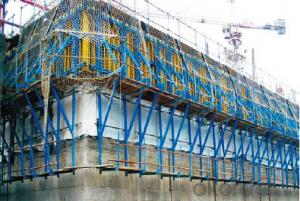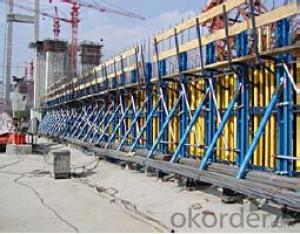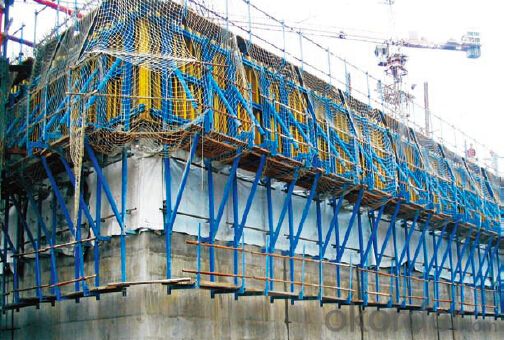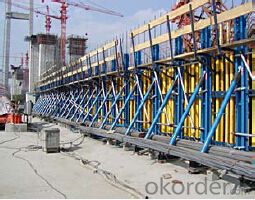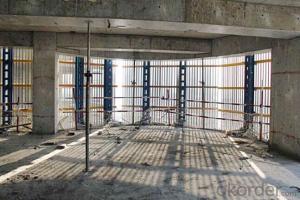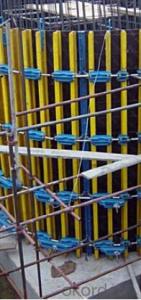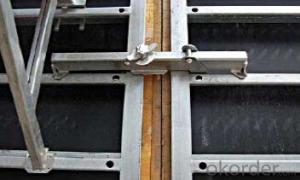Single-side Climbing Bracket SCB40 for formwork and scaffolding systems
- Loading Port:
- Tianjin
- Payment Terms:
- TT OR LC
- Min Order Qty:
- 50 m²
- Supply Capability:
- 1000 m²/month
OKorder Service Pledge
OKorder Financial Service
You Might Also Like
Single-side Climbing Bracket SCB180:
With CNBM SCB 180 climbing systems, the loads from the fresh concrete pressure are
transferred through the brackets by means of V-strongbacks and compression braces into the
scaffold anchors.
Typical applications for the SCB 180 are dams, locks, cooling towers, pier heads, tunnels, and
bank vaults.
The formwork is simply tilted backwards when striking takes place. The 1.80 m wide bracket
requires only a minimum of space.
Characteristics:
◆ Economical and safe anchoring
The M30/D20 climbing cones have been designed especially for single-sided concreting using
SCB180 in dam construction, and to allow the transfer of high tensile and shear forces into the still
fresh, unreinforced concrete. Without wall-through tie-rods, finished concrete is perfect.
◆ Stable and cost-effective for high loads
generous bracket spacings allow large-area formwork units with optimal utilization of the bearing
capacity. This leads to extremely economical solutions.
◆ Simple and flexible planning
With SCB180 single-sided climbing formwork, circular structures can also be concreted without
undergoing any large planning process. Even use on inclined walls is feasible without any special
measures because additional concrete loads or lifting forces can be safely transferred into the
structure.
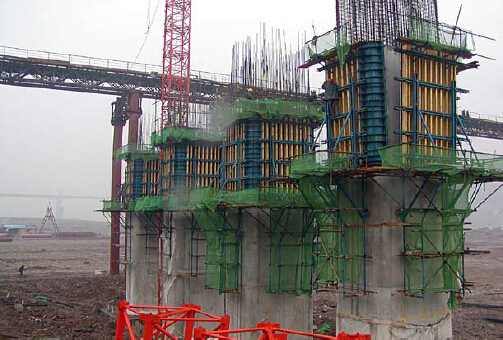
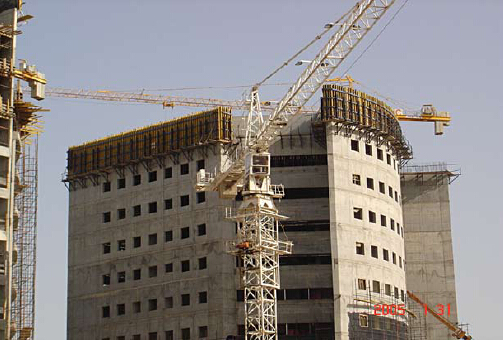
- Q: How is steel formwork supported during concrete pouring?
- During the pouring of concrete, steel formwork relies on a support system consisting of props, beams, and scaffolding. Props, which are vertical supports, are strategically positioned beneath the steel formwork to maintain stability and prevent any sagging or collapsing under the weight of the wet concrete. These props can be adjusted to achieve precise positioning and leveling of the formwork. In addition to props, horizontal beams are employed to provide additional support for the steel formwork. These beams are typically placed at regular intervals and connected to the props, creating a robust framework capable of withstanding the pressure exerted by the concrete. The beams also aid in distributing the load evenly across the formwork, ensuring its balance and security. Scaffolding is another essential component in supporting the steel formwork during concrete pouring. It is erected around the formwork to provide a secure working platform for workers to access and maneuver the formwork. Scaffolding also facilitates the installation and removal of the formwork, streamlining the construction process. In summary, the combination of props, beams, and scaffolding plays a crucial role in supporting steel formwork during concrete pouring. This support system ensures the stability of the formwork, allowing for accurate pouring and curing of the concrete, resulting in a structurally sound and long-lasting building.
- Q: What are the main components of a steel formwork system?
- The main components of a steel formwork system are the steel panels, walers, stiffeners, and connectors. 1. Steel Panels: These are the primary components of a steel formwork system. They are typically made of high-quality steel and come in various sizes and shapes. Steel panels provide the necessary strength and rigidity to hold the concrete in place during the construction process. They are designed to be easily assembled and disassembled, allowing for efficient use on different construction projects. 2. Walers: Walers are horizontal beams or rods that are used to connect and brace the steel panels. They help distribute the load of the concrete and provide additional strength to the formwork system. Walers are usually made of steel or timber and are placed along the edges of the formwork to maintain its shape and prevent any deformation. 3. Stiffeners: Stiffeners are vertical or diagonal members that are added to the steel formwork system to increase its stability and resistance to lateral forces. They are typically made of steel and are placed at regular intervals to provide additional support and prevent any buckling or twisting of the formwork system. Stiffeners are essential for ensuring the safety and integrity of the formwork during the pouring and curing of the concrete. 4. Connectors: Connectors are used to securely fasten the steel panels and other components of the formwork system. They can include various types of bolts, nuts, clamps, or pins. Connectors play a crucial role in maintaining the alignment and stability of the formwork, ensuring that it can withstand the pressure exerted by the wet concrete. They are designed to be easily adjustable and removable, allowing for quick assembly and disassembly of the formwork system. Overall, a steel formwork system is composed of steel panels, walers, stiffeners, and connectors. These components work together to provide the necessary strength, stability, and flexibility required for the construction of concrete structures. The use of steel in the formwork system ensures durability, reusability, and ease of assembly, making it a popular choice in the construction industry.
- Q: Is steel formwork more durable than other types of formwork?
- Compared to other types of formwork, steel formwork is undoubtedly more durable. This is due to the fact that steel is a robust and sturdy material capable of withstanding heavy loads and high pressures. Its resistance to wear and tear makes it ideal for construction projects that involve repetitive use of formwork. Unlike wood or plastic, steel formwork does not easily warp, crack, or deteriorate over time. This exceptional durability allows for multiple concrete pours without the need for frequent replacements, resulting in long-term cost savings. Furthermore, steel formwork's fire-resistant properties further enhance its durability and safety features. In conclusion, steel formwork is a reliable choice for construction projects, offering superior durability when compared to other types of formwork.
- Q: What is the process for installing steel formwork?
- The process for installing steel formwork typically involves the following steps: 1. Preparation: The site is cleared and leveled to ensure a smooth surface for the formwork installation. 2. Measurement and marking: The dimensions and layout of the formwork are measured and marked on the ground or existing structure. 3. Assembly: The steel formwork panels, which are designed to interlock, are assembled according to the marked dimensions. The panels are secured together using various connecting methods, such as bolts, clamps, or pins. 4. Alignment and leveling: The formwork is aligned and leveled using leveling devices, such as spirit levels or laser levels. This ensures that the formwork is perfectly straight and even. 5. Reinforcement placement: If required, steel reinforcement bars are placed within the formwork to strengthen the concrete structure. 6. Bracing and support: Additional bracing and support are installed to reinforce the formwork and prevent any movement during the concrete pouring process. 7. Concrete pouring: Once the formwork is in place and properly secured, concrete is poured into the formwork, filling the desired shape or structure. 8. Curing and removal: After the concrete has cured, the formwork is removed carefully to avoid damaging the newly formed structure. The removed formwork can be cleaned and reused for future projects if it is in good condition. It's important to note that the specific process may vary depending on the project requirements, design, and the type of steel formwork being used. Professional expertise and adherence to safety guidelines are essential during the installation process.
- Q: Are there any specific considerations for using steel formwork in areas with limited space?
- When using steel formwork in areas with limited space, there are several specific factors to consider. Firstly, it is important to carefully select the dimensions of the steel formwork system so that it can fit within the available space. This involves considering the height, width, and depth of the formwork components, as well as any necessary clearances for movement and installation. Secondly, careful planning is needed for the assembly and disassembly of the steel formwork system in order to minimize space requirements. This may involve using smaller formwork panels or modular systems that can be easily transported and maneuvered in tight spaces. Additionally, the order in which the formwork is removed should be considered to ensure there is enough space for workers and equipment to safely access the area. Thirdly, the storage of steel formwork components when not in use should be taken into account. In areas with limited space, it may be necessary to stack the formwork panels vertically or use compact storage solutions to maximize space efficiency. Lastly, the accessibility of the construction site should be considered. In areas with limited space, it may be challenging to transport and deliver the steel formwork components. Therefore, it is important to assess the availability of access roads, parking areas, and equipment staging areas to ensure the safe and efficient delivery of the steel formwork to the construction site. Overall, the use of steel formwork in areas with limited space requires careful planning and consideration of dimensions, assembly, disassembly, storage, and site accessibility. By addressing these specific factors, it is possible to effectively utilize steel formwork systems in tight spaces while ensuring the safety and efficiency of the construction process.
- Q: How does steel formwork affect the overall thermal insulation of a building?
- Steel formwork has minimal impact on the overall thermal insulation of a building. Since steel is a good conductor of heat, it does not provide sufficient insulation on its own. However, when combined with appropriate insulation materials, such as foam or mineral wool, steel formwork can contribute to a well-insulated building by providing structural support while the insulation material retains heat or cold temperatures.
- Q: Is steel formwork suitable for projects with tight deadlines?
- Yes, steel formwork is suitable for projects with tight deadlines. Steel formwork is known for its durability, strength, and versatility, allowing for faster construction processes. It can be assembled and disassembled quickly, enabling efficient workflow and reducing construction time. Additionally, steel formwork offers high-quality finishes, ensuring the timely completion of projects without compromising on the desired aesthetic appeal.
- Q: What are the different accessories required for steel formwork maintenance?
- The different accessories required for steel formwork maintenance include the following: 1. Formwork cleaning agents: These are used to remove any concrete residue or build-up on the steel formwork. They help in maintaining the smooth surface of the formwork and prevent any damage or corrosion. 2. Formwork release agents: These are applied to the steel formwork before pouring concrete to prevent it from sticking to the formwork. They help in easy removal of the formwork after the concrete has cured. 3. Formwork patching compounds: These are used to repair any damages or imperfections on the steel formwork. They help in maintaining the structural integrity of the formwork and ensure its longevity. 4. Formwork oil or grease: These lubricants are applied to the moving parts of the steel formwork, such as hinges or sliding mechanisms. They help in smooth operation and prevent any friction or wear and tear. 5. Formwork ties and connectors: These are used to secure the formwork panels together and ensure stability during concrete pouring. They should be regularly inspected and replaced if damaged or worn out. 6. Formwork wedges and pins: These are used to align and secure the formwork panels in place. They should be checked regularly to ensure proper positioning and stability. 7. Formwork clamps and brackets: These accessories are used to support and hold the formwork panels in position. They should be inspected for any signs of damage or weakness and replaced if necessary. 8. Formwork cleaning tools: These include brushes, scrapers, and high-pressure washers, which are used to clean the steel formwork. Regular cleaning helps in maintaining the formwork's appearance and prevents the accumulation of dirt or debris. 9. Formwork storage and transportation equipment: These include racks, trolleys, or storage containers, which are used to store and transport the steel formwork safely. Proper storage and transportation ensure the formwork's longevity and prevent any damage or distortion. Overall, the different accessories required for steel formwork maintenance are crucial to ensure the formwork's optimal performance, durability, and safety during concrete construction projects.
- Q: Are there any specific considerations for using steel formwork in areas with limited power supply?
- Yes, there are several specific considerations for using steel formwork in areas with limited power supply. Firstly, steel formwork typically requires power tools for assembly and disassembly. In areas with limited power supply, it may be challenging to operate these tools efficiently. Alternative methods such as manual tools or hand-held equipment may need to be used, which can significantly increase the time and labor required for formwork installation and removal. Secondly, steel formwork often requires welding or cutting, which typically relies on electricity. In areas with limited power supply, finding suitable alternatives for these processes becomes crucial. For example, gas-powered welding machines or oxy-fuel cutting equipment may need to be considered. However, these alternatives come with their own set of challenges, such as obtaining and storing fuel safely. Additionally, areas with limited power supply may also face issues related to lighting. Adequate lighting is essential during formwork installation and concrete pouring to ensure accuracy and safety. Using alternative lighting sources such as battery-powered or solar-powered lights may be necessary. Furthermore, steel formwork often requires proper cleaning and maintenance to ensure its longevity and reusability. Cleaning equipment, such as pressure washers or power scrubbers, may not be readily available in areas with limited power supply. In such cases, manual cleaning methods or low-power alternatives may need to be employed. Lastly, power supply limitations may also affect the overall productivity and efficiency of the construction project. With limited power, it may be necessary to carefully plan and schedule the use of power-intensive equipment, such as concrete mixers or pumps, to minimize disruptions and maximize the available power resources. In conclusion, using steel formwork in areas with limited power supply requires careful consideration and planning. Alternative methods, tools, and equipment may need to be employed to overcome the challenges posed by the lack of power availability. It is essential to assess the specific requirements of the project and consult with experts to ensure the successful implementation of steel formwork in such areas.
- Q: What is the 86 series steel formwork
- Steel template (also called undismantled Mould Network) can replace the wood template, significantly reduced usually with wood, plywood, steel plate or other traditional sealing template on the pore water pressure and the pressure in the bubble concrete elimination; steel template (undismantled Mould Network) structure of concrete casting, forming an ideal rough interface. Do not need to rough cutting operations can enter the next construction processThe utility model can be placed before installing the reinforcing steel bar, and can also be placed after installing the reinforcing steel bar. If it is installed before the installation of steel, easy installation and easy to install; concrete pouring process can be visually monitored, thereby reducing the risk of the emergence of pores and honeycomb structure and other phenomena.
Send your message to us
Single-side Climbing Bracket SCB40 for formwork and scaffolding systems
- Loading Port:
- Tianjin
- Payment Terms:
- TT OR LC
- Min Order Qty:
- 50 m²
- Supply Capability:
- 1000 m²/month
OKorder Service Pledge
OKorder Financial Service
Similar products
Hot products
Hot Searches
